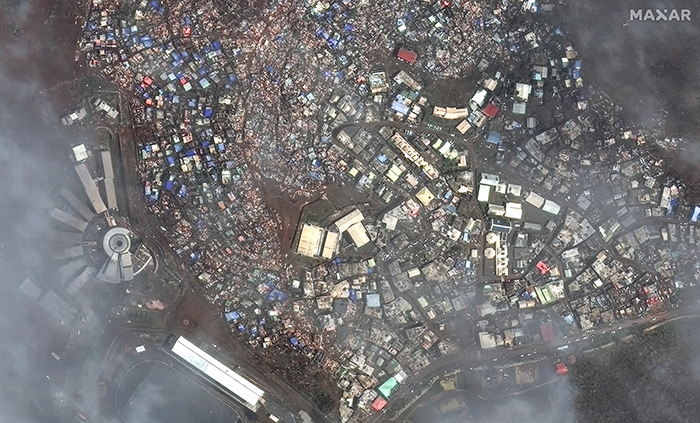Interviews / Human Security
17 January 2025
Natural Disasters in Mayotte: France’s Overseas Policy Put to the Test

The passage of Cyclones Chido on 14 December 2024 and Dikeledi on 12 January severely impacted the island of Mayotte, a French overseas department located in the Indian Ocean. The damage to infrastructure and human lives is significant, and the full extent remains unknown. In the face of the humanitarian disaster, the French government’s response has drawn criticism, particularly regarding its management of the large population of Comorian origin living illegally on the island, who were especially affected by the storms. What is the current humanitarian situation in Mayotte? What strategy has Paris implemented to rebuild the island? What impact will this policy have on Comorian immigrants? With New Caledonia and Martinique also under strain, how can we assess France’s overseas policy? Insights from Fatou-Élise Ba, a researcher at IRIS and head of the Humanitarian and Development Programme.
Le cyclone Chido a provoqué une catastrophe majeure à Mayotte. À quel point le département français était-il préparé à ce type d’évènement ? Quel est le niveau de vulnérabilité de l’île face aux crises de l’eau et de la faim ?
The current situation in Mayotte following Cyclone Chido’s passage on 14 December 2024 is deeply alarming for several reasons. First, the territory lies in an area highly exposed to cyclonic phenomena. The devastation caused by Chido was further exacerbated by the tropical storm Dikeledi, which triggered significant flooding in the southern regions, some of which had been spared by Chido. Mayotte’s structural vulnerabilities have amplified the cyclone’s impact, leaving the territory grappling with severe health and socio-economic challenges. A staggering 77 % of the population lives below the national poverty line. As one of France’s poorest departments, the population lacks the means to protect itself from environmental hazards or implement crisis and disaster preparedness strategies.
Even before the cyclone, Mayotte was already in a precarious humanitarian situation. Healthcare infrastructure was extremely fragile and overwhelmed. The Mamoudzou hospital was already operating beyond capacity, and healthcare needs were intensified by widespread poverty and the prevalence of infectious diseases such as tuberculosis and dengue fever. The measures implemented to address Mayotte’s challenges were largely insufficient to combat the high levels of poverty. Additionally, Mayotte experienced several drought episodes and acute water shortages, with a major water crisis occurring in 2023. By mid-2024, access to clean water was still intermittent. At the start of 2024, the archipelago also faced a cholera outbreak caused by inadequate sanitation access and suffered severe impacts from climate change. The weakness of its infrastructure, combined with the considerable population growth on the island and the resulting increased needs, highlighted a situation already under strain when Chido struck. Moreover, a significant portion of the population lived in precarious housing, often without access to running water. As of early 2024, only 71 % of residents had access to running water in their homes. The cyclone destroyed numerous densely populated neighbourhoods and informal settlements in its path.
In the aftermath of Chido, official figures report 39 deaths and several thousand injuries. However, the actual number of victims is likely much higher. Given that Mayotte is home to many undocumented individuals, numerous victims were probably not accounted for.
Chido and Dikeledi have significantly worsened pre-existing issues in Mayotte, disproportionately affecting the most vulnerable populations and exacerbating already severe inequalities in resource distribution on the island. Currently, the risks of food and water shortages remain high. Furthermore, additional extreme weather events are anticipated, such as Kashkasi, a monsoon phenomenon associated with heavy rainfall, posing further threats to human security in Mayotte. Multiple layers of vulnerability converge on the territory, which remains heavily reliant on external aid.
What strategy is the French government implementing to rebuild Mayotte? To what extent could this process affect the lives of the hundreds of thousands of Comorian immigrants living illegally on the island?
Faced with high levels of poverty, several NGOs have criticised the French government for its underinvestment in Mayotte, particularly in healthcare, housing, and education. Additionally, solidarity actors expect the reconstruction plan for Mayotte to address the archipelago’s structural issues.
The French government must act urgently to respond to the crisis in Mayotte and the scale of the damage a month after Cyclone Chido’s passage. During a visit to Mayotte on 30 December, French Prime Minister François Bayrou presented the “Mayotte Standing” plan. Subsequently, an emergency bill for Mayotte was adopted on Wednesday, 15 January, by the Economic Affairs Committee of the National Assembly. This bill aims to rebuild housing for disaster victims, restore infrastructure, and invest in more “structural” measures, according to Overseas Minister Manuel Valls. However, the opposition considers the bill insufficient to address the numerous challenges Mayotte faces. It is scheduled to be debated in the National Assembly on 20 January 2025.
The European Union has also announced a solidarity initiative to support communities affected by Chido in Mayotte and Mozambique through emergency humanitarian aid. Specifically for Mayotte, the EU’s Civil Protection Mechanism has been activated. Additional support for Mayotte to cope with natural disasters may be considered.
The catastrophe on the island has sparked strong reactions from French politicians. Illegal immigration and the construction of unauthorised housing have been criticised by the ruling political class. Furthermore, the Chido tragedy has intensified resentment among the Mahorais regarding migration issues. It is important to note that undocumented immigrants represent the most vulnerable segment of the island’s population and are the most exposed to environmental hazards. Many of them lived in informal settlements that were destroyed by the cyclones.
The French government has discussed tightening measures against immigration in Mayotte as part of the urgent reconstruction plan, including plans by the Bayrou administration to reform birthright citizenship on the island. In Mayotte, half of the population is composed of undocumented immigrants, most of whom live in extreme poverty. This population is generally ineligible for social benefits and has limited access to stable employment. Migration issues in Mayotte are primarily managed through security measures by the French government, such as the 2023 Wuambushu operation, which aimed to evict undocumented individuals and organise deportations by boat. These policies primarily target immigrants from the Comoros. This stance was reaffirmed by Interior Minister Bruno Retailleau following Cyclone Chido, but his remarks were poorly received by the Comorian government.
Despite tensions between France and the Comoros, many Comorian associations have organised to assist Chido’s victims. Civil society organisations remain mobilised and are at the forefront of maintaining solidarity between communities.
A tense situation is expected due to the security-driven management of irregular immigration from the Comoros. Moreover, stricter policies to limit immigration are unlikely to deter irregular migration flows. Instead, the risks taken by migrants and the dangerous behaviour of smugglers are likely to increase, leading to more casualties. Numerous shipwrecks have occurred between Anjouan and Mayotte, including the tragic incident on 1 November 2024, which resulted in at least 25 deaths.
What policies is France implementing for the development of its overseas territories, particularly in the context of the tensions observed in Martinique and New Caledonia?
Contrary to what current events might suggest, the questioning of France’s overseas territories is not a new phenomenon. It is tied to numerous structural issues and contradictions within the French assimilationist model.
The tensions in Martinique and New Caledonia during 2023–2024 were particularly notable. What these territories have in common relates primarily to socio-economic challenges, such as the “fight against the high cost of living” in Martinique, tensions in New Caledonia linked to nickel production, or the precarious living conditions in Mayotte. According to INSEE, there is a significant gap between the per capita GDP of mainland regions and that of the overseas departments and regions (DROM). Social inequalities are further exacerbated by significantly higher prices compared to mainland France. Unemployment rates are also much higher, with 43% in Mayotte and nearly 12% in Martinique.
France allocates a substantial budget to the development of its overseas territories, but this is insufficient to ensure economic prosperity or to anticipate potential crises. The measures taken to combat inflation are minimal compared to the persistent inequalities in the overseas territories, despite increased investment from the state.

